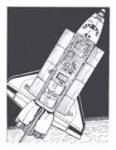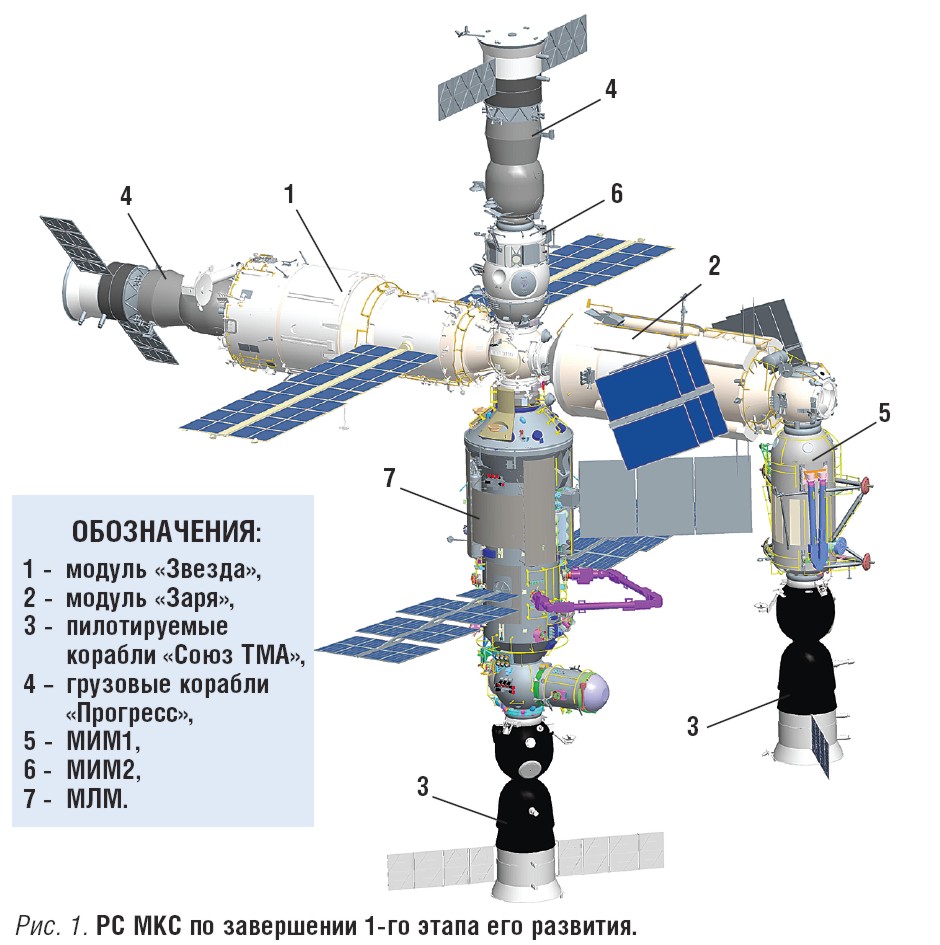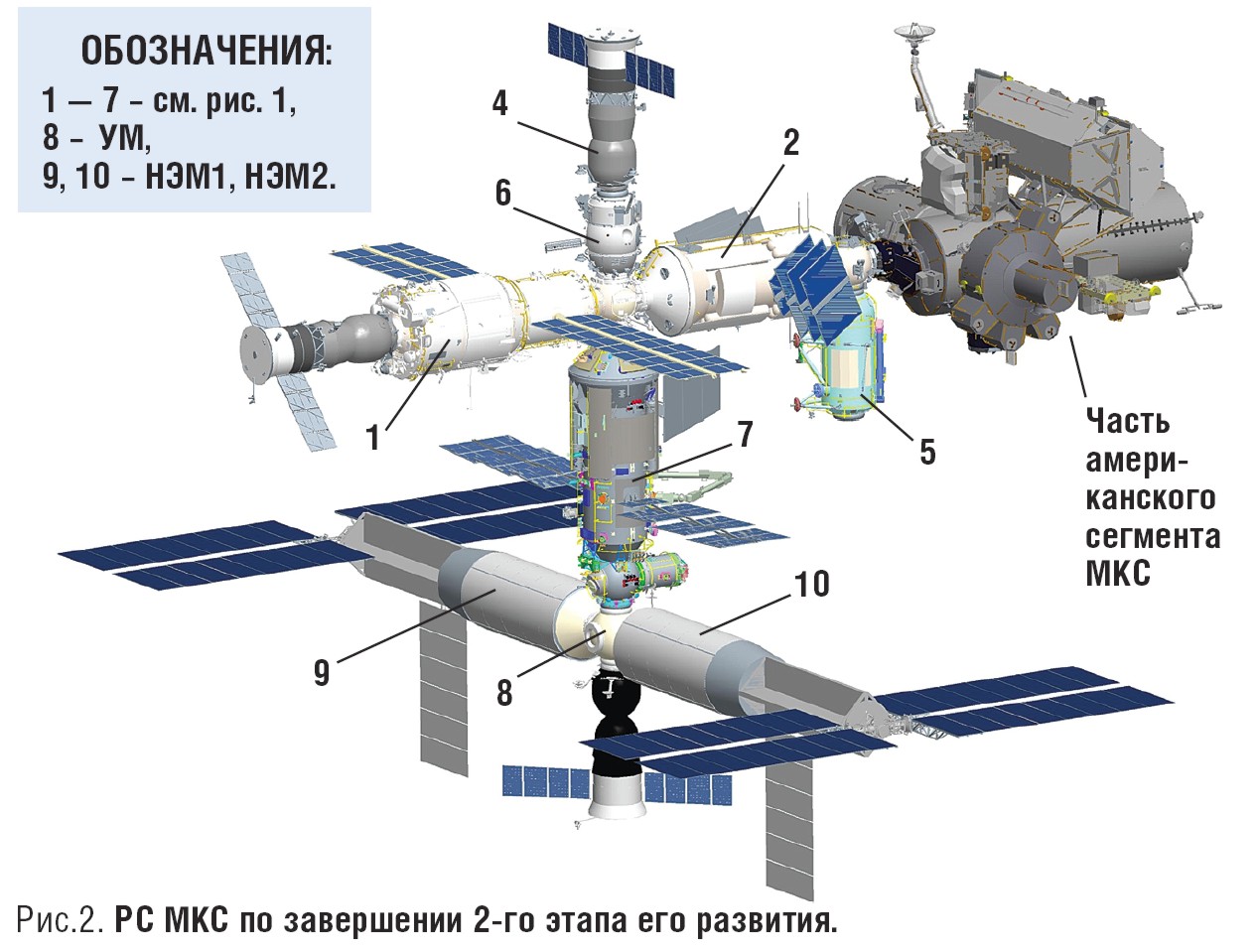la Russie ajoutera 3 modules à son segment avant 2011
Page 3 sur 5
Page 3 sur 5 •  1, 2, 3, 4, 5
1, 2, 3, 4, 5 
Steph a écrit:(je ne retrouve plus le sujet sur les modules russes de l'ISS, si quelqu'un pouvait me le signaler :roll: )
C'est peut-être cela ?
http://www.forum-conquete-spatiale.fr/iss-f30/la-russie-ajoutera-3-modules-a-son-segment-avant-2011-t4472.htm
Nota : On y annonçait le lancement d'un module par la navette (on s'interrogeait là dessus aussi dans un FIL récent)
Ce qui ne colle pas vraiment avec les prévisions des vols puisque STS-131 est prévue pour ELC3. Ce module sera probablement lancé par une Proton.Le DCM sera livré aux USA en juin 2009 et sera lancé en 2010 par STS 131 avant le Node 3.
Bref ... on patauge dans le yaourt :wall: :wall: :wall:
montmein69- Donateur

- Messages : 20962
Inscrit le : 01/10/2005
Après 2011, la Russie ajoutera deux modules énergétiques
Ceci est intéressant car cela peut vouloir dire le souhait des russes d'avoir une certaine indépendance énergétique à bord.

montmein69- Donateur

- Messages : 20962
Inscrit le : 01/10/2005
Age : 73
Localisation : région lyonnaise
Merci, je fusionne.montmein69 a écrit:Steph a écrit:(je ne retrouve plus le sujet sur les modules russes de l'ISS, si quelqu'un pouvait me le signaler :roll: )
C'est peut-être cela ?
http://www.forum-conquete-spatiale.fr/iss-f30/la-russie-ajoutera-3-modules-a-son-segment-avant-2011-t4472.htm

Invité- Invité
N'est ce pas déjà le cas avec les panneaux de zvevda et zarya ?montmein69 a écrit:
Après 2011, la Russie ajoutera deux modules énergétiques
Ceci est intéressant car cela peut vouloir dire le souhait des russes d'avoir une certaine indépendance énergétique à bord.

vp- Messages : 4557
Inscrit le : 21/09/2005
Age : 50
Localisation : RP
Je ne pense pas. De plus, avec la confguration définitive (et actuelle) de l'ISS, les panneaux de Zarya sont repliés

Dirk De Winne- Messages : 1396
Inscrit le : 14/08/2006
Age : 41
Localisation : Bruxelles
Souhaitant ajouter à la confusion je mets cet article
http://en.rian.ru/russia/20080410/104778286.html
Russian ISS segment construction delayed for 5 years
MISSION CONTROL, April 10 (RIA Novosti) - The construction of the Russian segment for the International Space Station will be delayed for five years due to insufficient funding, the head of Russia's space rocket corporation said on Thursday.
"We should have completed construction by 2010, but unfortunately we will only manage it by 2015," Energia President Vitaly Lopota said.
He said as a result Russia will request that foreign partners extend the life span of the ISS by five years to 2020. etc etc
C'est bien les gars avec qui ont veut construire le CSTS ? :pale:
http://en.rian.ru/russia/20080410/104778286.html
Russian ISS segment construction delayed for 5 years
MISSION CONTROL, April 10 (RIA Novosti) - The construction of the Russian segment for the International Space Station will be delayed for five years due to insufficient funding, the head of Russia's space rocket corporation said on Thursday.
"We should have completed construction by 2010, but unfortunately we will only manage it by 2015," Energia President Vitaly Lopota said.
He said as a result Russia will request that foreign partners extend the life span of the ISS by five years to 2020. etc etc
C'est bien les gars avec qui ont veut construire le CSTS ? :pale:

jassifun- Messages : 4968
Inscrit le : 07/06/2007
Age : 37
Localisation : Baden Baden
Rien de confus au contraire c'est la façon dont informe la Russie depuis des lustres : en lançant une info et son contraire.
La decription qui est la mienne, c'est que la Russie veut relancer son programme spatial et comme elle en a les moyens elle le fera. Par contre, elle a également pour objectif de soutirer un maximum de devise de la part de l'Europe, Japon ...
C'est pour cela que je pense que les Russes feront un nouveau vaisseau de 6 places pour 2015 avec ou sans l'Europe.
La decription qui est la mienne, c'est que la Russie veut relancer son programme spatial et comme elle en a les moyens elle le fera. Par contre, elle a également pour objectif de soutirer un maximum de devise de la part de l'Europe, Japon ...
C'est pour cela que je pense que les Russes feront un nouveau vaisseau de 6 places pour 2015 avec ou sans l'Europe.

vp- Messages : 4557
Inscrit le : 21/09/2005
Age : 50
Localisation : RP
Russia needs $5 bln to complete its ISS segment - Energia
15:56 | 11/ 04/ 2008
MOSCOW, April 11 (RIA Novosti) - Russia will need an additional $5 billion to finish the construction of its segment of the International Space Station (ISS) by 2015, the head of Russia's rocket and space corporation Energia said Friday.
The ISS is a joint project of space agencies from the United States, Russia, Europe, Canada and Japan. The orbital station is likely to remain operational until 2020.
"So far, we have allocated about $4.2 billion for the ISS project, but we will need an additional $5 billion to finish the construction [of the Russian segment] by 2015," Energia President Vitaly Lopota said at a conference dedicated to Cosmonautics Day, celebrated in Russia on April 12.
The first ISS element, the Russian Zarya module, was put into orbit in November 1998. Several modules have been attached to the structure since then, but ongoing construction has missed the initial deadline, largely due to delays in U.S. shuttle launches and a lack of financing.
The Russian segment of the orbital station should have 10 modules by 2015, the Energia official said.
Russia is planning to launch two small research modules to the ISS in 2009-2010, a multi-purpose laboratory module - in 2011, and two energy modules - in 2014-2015.
The ISS crew will comprise six members, including three Russian cosmonauts, starting from 2009, Lopota said.
15:56 | 11/ 04/ 2008
MOSCOW, April 11 (RIA Novosti) - Russia will need an additional $5 billion to finish the construction of its segment of the International Space Station (ISS) by 2015, the head of Russia's rocket and space corporation Energia said Friday.
The ISS is a joint project of space agencies from the United States, Russia, Europe, Canada and Japan. The orbital station is likely to remain operational until 2020.
"So far, we have allocated about $4.2 billion for the ISS project, but we will need an additional $5 billion to finish the construction [of the Russian segment] by 2015," Energia President Vitaly Lopota said at a conference dedicated to Cosmonautics Day, celebrated in Russia on April 12.
The first ISS element, the Russian Zarya module, was put into orbit in November 1998. Several modules have been attached to the structure since then, but ongoing construction has missed the initial deadline, largely due to delays in U.S. shuttle launches and a lack of financing.
The Russian segment of the orbital station should have 10 modules by 2015, the Energia official said.
Russia is planning to launch two small research modules to the ISS in 2009-2010, a multi-purpose laboratory module - in 2011, and two energy modules - in 2014-2015.
The ISS crew will comprise six members, including three Russian cosmonauts, starting from 2009, Lopota said.
patchfree a écrit:The Russian segment of the orbital station should have 10 modules by 2015, the Energia official said.
:shock:
que quoi ???
vous y arriver comment ? zarya, zvezda, pirs, plus quel autres modules ???? c'est la grande question ca, avec toutes ces annonces...

yoann- Messages : 5781
Inscrit le : 31/01/2007
Age : 39
Localisation : indre et loire
patchfree a écrit:Russia needs $5 bln to complete its ISS segment - Energia
15:56 | 11/ 04/ 2008
MOSCOW, April 11 (RIA Novosti) - Russia will need an additional $5 billion to finish the construction of its segment of the International Space Station (ISS) by 2015, the head of Russia's rocket and space corporation Energia said Friday.
La valse des annonces "pessimistes" assorties de "demande de rallonge budgétaire" est aussi bien rodée que celle de la NASA
Russia is planning to launch ../cut/... a multi-purpose laboratory module - in
2011
Avec cette date on lève les interrogations sur un transport par la navette. Ce sera une Proton, et il faut prévoir un système d'amarrage automatique.
, and two energy modules - in 2014-2015.
On avait discuté à plusieurs reprises de la suppression du mat russe - baptisé Science Power Platform - équipé de panneaux solaires (sur ce même FIL vers le 10 janvier) ... et de l'achat par la russie de l'énergie électrique (des grands panneaux solaires) aux américains à un prix assez élevé.
Cette annonce pourrait être un indice que la russie modifie ses options. Mais il faut bien sûr rester très circonspect et voir la tête que pourraient avoir ces différents modules annoncés :scratch:

montmein69- Donateur

- Messages : 20962
Inscrit le : 01/10/2005
Age : 73
Localisation : région lyonnaise
Encore une info concernant la partie russe :
http://www.flightglobal.com/articles/2008/07/22/225946/russias-federal-space-agency-announces-more-iss-modules.html
The additional ISS modules were announced by FSA chief Anatoly Perminov at a heads of agency meeting in Paris on 17 July. NASA's Space Shuttle launch manifest details three modules. The Mini Research Module 2 (MRM2), being delivered by a Russian launcher in 2009, the MRM1 that is installed by NASA's Space Shuttle Discovery's crew on mission STS-132 in 2010 and a Proton rocket-delivered multipurpose laboratory module targeted for 2011. The Shuttle mission STS-132 is described as a contingency, but NASA has recently said that it will fly both its contingency missions, STS-132 and STS-133.
The 17 July meeting's joint statement referred to Russian modules being provided in 2009 and 2010. Perminov went further, saying: "Before 2011 we will be launching two small research modules. If a decision is made to continue working with the station after 2015 then the Russian segment will be completed with further modules - energy modules, research modules etc."

http://www.flightglobal.com/articles/2008/07/22/225946/russias-federal-space-agency-announces-more-iss-modules.html
The additional ISS modules were announced by FSA chief Anatoly Perminov at a heads of agency meeting in Paris on 17 July. NASA's Space Shuttle launch manifest details three modules. The Mini Research Module 2 (MRM2), being delivered by a Russian launcher in 2009, the MRM1 that is installed by NASA's Space Shuttle Discovery's crew on mission STS-132 in 2010 and a Proton rocket-delivered multipurpose laboratory module targeted for 2011. The Shuttle mission STS-132 is described as a contingency, but NASA has recently said that it will fly both its contingency missions, STS-132 and STS-133.
The 17 July meeting's joint statement referred to Russian modules being provided in 2009 and 2010. Perminov went further, saying: "Before 2011 we will be launching two small research modules. If a decision is made to continue working with the station after 2015 then the Russian segment will be completed with further modules - energy modules, research modules etc."


Invité- Invité
http://forum.nasaspaceflight.com/index.php?topic=2881.msg298364#msg298364
http://www.novosti-kosmonavtiki.ru/content/numbers/306/index.shtml
Voici un article intéressant de Novosti Kosmonavtiki sur le segment russe, traduit en anglais.
© Novosti Kosmonavtiki
Program for Development of the Russian ISS Segment
Sergey Shamsutdinov
«Novosti kosmonavtiki»
ISS construction is at last entering its final stage. Recently European “Columbus” module was added to the station followed by Japanese “Kibo” module. At the end of 2009 shuttle will deliver to ISS the last elements of the American segment – Node 3 and “Cupola”. As a result of these activities, Russian ISS partners (USA, Canada, ESA and Japan) starting from 2010 will have a complete segment and would be able to start its full scale utilization, doing science and research for their respective national space agencies.
And what is happening with our Russian segment (RS)? At the moment it consists of 3 modules: FGB “Zarya”, SM “Zvezda” and docking compartment “Pirs”. And FGB “Zarya” legally belongs to USA, since it is built under contract paid by Americans. It is considered part of the RS only because it is managed by MCC-M and serviced mainly by Russian cosmonauts. In accordance to Vitaly Lopota, President of RKK “Energia”, Federal Space Program initially envisaged 10 Russian modules at ISS by 2010, but due to underfinacing construction of RS is delayed. Production and launches of modules have been moved to the right for the indefinite period of time. Therefore RKK “Energia”, being responsible for development and operation of RS, prepared an updated program of development of ISS RS. It is now planned to launch 6 new modules for the RS during 2009-2015 in the following order:
Mini Research Module -2 – Docking Compartment -2, MRM-2 – DC2 (malii issledovatelskiy modul 2 – stykovochny otsek 2, МИМ2-СО2) will be used to create the fourth docking port at ISS for Soyuz and Progress ships and enable fuel transfer to ISS. Such additional docking compartment is required to increase ISS crew to 6 persons, since constant presence of 2 Soyuz ships at the station is required in this case. Also this module could be used for EVAs.
Main technical specifications of the module: mass – 4000 kg, diameter – 2.6 m, length – 4.6 m, pressurized volume – 12.5 m3, cargo weight to be delivered inside the module – 1000 kg, storage volume inside the module - 2.5 m3, one workplace for the scientific equipment on an external surface of the module. Launch of the module is planned for August 2009 by Soyuz-FG rocket. It would be delivered to ISS with the help of special cargo ship Progress M – CO2 (#302, mass at launch 7290 kg) and would be docked to zenith port of “Zvezda” SM.
Mini Research Module – 1- Docking and Cargo Module, MRM-1 - DCM (Maliy issledovatelskiy modul-1 – stykovochno-gruzovoi modul, МИМ1-СГМ) will be used to ensure operations of Soyuz and Progress, as well as to deliver various cargo to ISS. This module is constructed under contract with NASA, its full description is in Novosti Kosmonavtiki, issue # 6 for 2007, pages 20-21.
Main technical specifications of the module: mass at start – 7900 kg, diameter – 2.4 m, length – 6.55 m, pressurized volume – 18 m3, pressurized storage volume inside the module - 5 m3, one workplace for the scientific equipment on an external surface of the module. The following cargo would be delivered at the exterior of the module: MLM airlock, MLM radiator, spare elbow joint for European Manipulator Arm (ERA) and transferable workplace with ERA mounting platform. All those elements would be transferred to MLM in the future.
MRM-1 – DCM launch is planned for March 2010 at STS-132/ISS-ULF4. Module would be installed at the nadir port of FGB “Zarya”.
Multipurpose Laboratory Module, MLM (mnogotselevoy laboratorniy modul (МЛМ) would be the main functional element of ISS RS which would ensure scientific utilization of RS (SM, FGB and Pirs are used primarily for ISS maintenance). MLM is created as multi-purpose scientific laboratory, which would be capable of handling rotating science payloads under Russian and foreign science programs. MLM inclusion in the RS will allow to significantly increase RS scientific capacity for fundamental and applied research projects. Module would be equipped with 12 external workplaces and several internal unified workplaces, as well as with vibration-protected workplaces, thermostatic equipment, manipulator and automated airlock.
Main technical specifications of the module: mass – 20700 kg, diameter – 4.1 m, length – 13.2 m, pressurized volume – 70 m3, pressurized storage volume inside the module - up to 8 m3, power available for scientific experiments – up to 2.5 kW. It is expected that MLM will be launched in 2011 by Proton-M rocket. It will then use its own engines to fly to ISS and would be docked to the nadir docking port at SM “Zvezda”. Docking Compartment - 1 is located at this port at the moment and therefore before MLM launch DC-1 would be undocked with the help of Progress ship and then deorbited.
Node module, NM (uzlovoy modul (УМ) is required to integrate in RS two science power modules and provide additional docking ports. Main technical specifications of the module: mass – 4000 kg, pressurized volume – 14 m3, docking ports available – 5. Launch of the module is planned for 2013 by Soyuz rocket. It would be delivered to ISS with the help of special cargo ship Progress M – УМ (#303) and would be docked to MLM.
Science Power Module, SPM (nauchno-energeticheskiy modul (НЭМ) is required to ensure independent power supply to ISS. Main technical specifications of the module: mass – 20000 kg, diameter – 4.1 m, length – 25.3 m, dimensions with the fully deployed solar arrays and radiator - 26.5х25.3х10.5 m, pressurized volume – up to 150 m3, pressurized volume for scientific equipment - 12 m3, solar arrays power capacity – 36 kW, 12 workplaces. In accordance with agreement with NASA RS is partially supplied with power from American segment but this is possible only till 2015. For further RS operations it should have its own power system, and it is envisaged to have 2 similar modules for this purpose - SPM-1 in 2014 and SPM-2 in 2015. They would be launched by Proton-M rockets and would be docked to port and aft docking ports of the NM.
Therefore, by 2015 the ISS RS will include 8 modules: FGB “Zarya”, SM “Zvezda”, MLM, MRM-1-CDM, MRM-2-DC2, NM, SPM-1 and SPM-2. RS total mass would be 122 tones, pressurized volume – up to 400 m3, power capacity – 80 kW.
Such projected configuration of the ISS RS allows, if required, to start independent flight of the RS as a separate Russian orbital station.
Full scale deployment of RS will allow Russian continuous presence in space, will provide an opportunity for fundamental scientific research, will give a chance for development of unique new materials, and will provide an opportunity for additional commercial services in space. In a longer term perspective ISS RS could be used for development, assembly and maintenance of the lunar and interplanetary flights.
ISS RS development program is approved by the Scientific and Technical Council of RKK “Energia” and Roskosmos management. It should now get the endorsement of the Russian government and receive full financing. Only in this case the full-scale ISS RS could be completed.
Author appreciates contribution of RKK “Energia” President and General Designer Vitaly Lopota and Deputy General Designer Nikolay Bryukhanov who provided information materials for this article.




http://www.novosti-kosmonavtiki.ru/content/numbers/306/index.shtml
Voici un article intéressant de Novosti Kosmonavtiki sur le segment russe, traduit en anglais.
© Novosti Kosmonavtiki
Program for Development of the Russian ISS Segment
Sergey Shamsutdinov
«Novosti kosmonavtiki»
ISS construction is at last entering its final stage. Recently European “Columbus” module was added to the station followed by Japanese “Kibo” module. At the end of 2009 shuttle will deliver to ISS the last elements of the American segment – Node 3 and “Cupola”. As a result of these activities, Russian ISS partners (USA, Canada, ESA and Japan) starting from 2010 will have a complete segment and would be able to start its full scale utilization, doing science and research for their respective national space agencies.
And what is happening with our Russian segment (RS)? At the moment it consists of 3 modules: FGB “Zarya”, SM “Zvezda” and docking compartment “Pirs”. And FGB “Zarya” legally belongs to USA, since it is built under contract paid by Americans. It is considered part of the RS only because it is managed by MCC-M and serviced mainly by Russian cosmonauts. In accordance to Vitaly Lopota, President of RKK “Energia”, Federal Space Program initially envisaged 10 Russian modules at ISS by 2010, but due to underfinacing construction of RS is delayed. Production and launches of modules have been moved to the right for the indefinite period of time. Therefore RKK “Energia”, being responsible for development and operation of RS, prepared an updated program of development of ISS RS. It is now planned to launch 6 new modules for the RS during 2009-2015 in the following order:
Mini Research Module -2 – Docking Compartment -2, MRM-2 – DC2 (malii issledovatelskiy modul 2 – stykovochny otsek 2, МИМ2-СО2) will be used to create the fourth docking port at ISS for Soyuz and Progress ships and enable fuel transfer to ISS. Such additional docking compartment is required to increase ISS crew to 6 persons, since constant presence of 2 Soyuz ships at the station is required in this case. Also this module could be used for EVAs.
Main technical specifications of the module: mass – 4000 kg, diameter – 2.6 m, length – 4.6 m, pressurized volume – 12.5 m3, cargo weight to be delivered inside the module – 1000 kg, storage volume inside the module - 2.5 m3, one workplace for the scientific equipment on an external surface of the module. Launch of the module is planned for August 2009 by Soyuz-FG rocket. It would be delivered to ISS with the help of special cargo ship Progress M – CO2 (#302, mass at launch 7290 kg) and would be docked to zenith port of “Zvezda” SM.
Mini Research Module – 1- Docking and Cargo Module, MRM-1 - DCM (Maliy issledovatelskiy modul-1 – stykovochno-gruzovoi modul, МИМ1-СГМ) will be used to ensure operations of Soyuz and Progress, as well as to deliver various cargo to ISS. This module is constructed under contract with NASA, its full description is in Novosti Kosmonavtiki, issue # 6 for 2007, pages 20-21.
Main technical specifications of the module: mass at start – 7900 kg, diameter – 2.4 m, length – 6.55 m, pressurized volume – 18 m3, pressurized storage volume inside the module - 5 m3, one workplace for the scientific equipment on an external surface of the module. The following cargo would be delivered at the exterior of the module: MLM airlock, MLM radiator, spare elbow joint for European Manipulator Arm (ERA) and transferable workplace with ERA mounting platform. All those elements would be transferred to MLM in the future.
MRM-1 – DCM launch is planned for March 2010 at STS-132/ISS-ULF4. Module would be installed at the nadir port of FGB “Zarya”.
Multipurpose Laboratory Module, MLM (mnogotselevoy laboratorniy modul (МЛМ) would be the main functional element of ISS RS which would ensure scientific utilization of RS (SM, FGB and Pirs are used primarily for ISS maintenance). MLM is created as multi-purpose scientific laboratory, which would be capable of handling rotating science payloads under Russian and foreign science programs. MLM inclusion in the RS will allow to significantly increase RS scientific capacity for fundamental and applied research projects. Module would be equipped with 12 external workplaces and several internal unified workplaces, as well as with vibration-protected workplaces, thermostatic equipment, manipulator and automated airlock.
Main technical specifications of the module: mass – 20700 kg, diameter – 4.1 m, length – 13.2 m, pressurized volume – 70 m3, pressurized storage volume inside the module - up to 8 m3, power available for scientific experiments – up to 2.5 kW. It is expected that MLM will be launched in 2011 by Proton-M rocket. It will then use its own engines to fly to ISS and would be docked to the nadir docking port at SM “Zvezda”. Docking Compartment - 1 is located at this port at the moment and therefore before MLM launch DC-1 would be undocked with the help of Progress ship and then deorbited.
Node module, NM (uzlovoy modul (УМ) is required to integrate in RS two science power modules and provide additional docking ports. Main technical specifications of the module: mass – 4000 kg, pressurized volume – 14 m3, docking ports available – 5. Launch of the module is planned for 2013 by Soyuz rocket. It would be delivered to ISS with the help of special cargo ship Progress M – УМ (#303) and would be docked to MLM.
Science Power Module, SPM (nauchno-energeticheskiy modul (НЭМ) is required to ensure independent power supply to ISS. Main technical specifications of the module: mass – 20000 kg, diameter – 4.1 m, length – 25.3 m, dimensions with the fully deployed solar arrays and radiator - 26.5х25.3х10.5 m, pressurized volume – up to 150 m3, pressurized volume for scientific equipment - 12 m3, solar arrays power capacity – 36 kW, 12 workplaces. In accordance with agreement with NASA RS is partially supplied with power from American segment but this is possible only till 2015. For further RS operations it should have its own power system, and it is envisaged to have 2 similar modules for this purpose - SPM-1 in 2014 and SPM-2 in 2015. They would be launched by Proton-M rockets and would be docked to port and aft docking ports of the NM.
Therefore, by 2015 the ISS RS will include 8 modules: FGB “Zarya”, SM “Zvezda”, MLM, MRM-1-CDM, MRM-2-DC2, NM, SPM-1 and SPM-2. RS total mass would be 122 tones, pressurized volume – up to 400 m3, power capacity – 80 kW.
Such projected configuration of the ISS RS allows, if required, to start independent flight of the RS as a separate Russian orbital station.
Full scale deployment of RS will allow Russian continuous presence in space, will provide an opportunity for fundamental scientific research, will give a chance for development of unique new materials, and will provide an opportunity for additional commercial services in space. In a longer term perspective ISS RS could be used for development, assembly and maintenance of the lunar and interplanetary flights.
ISS RS development program is approved by the Scientific and Technical Council of RKK “Energia” and Roskosmos management. It should now get the endorsement of the Russian government and receive full financing. Only in this case the full-scale ISS RS could be completed.
Author appreciates contribution of RKK “Energia” President and General Designer Vitaly Lopota and Deputy General Designer Nikolay Bryukhanov who provided information materials for this article.





Invité- Invité
Très intéressant, merci. Les projets russes étaient devenus très flou ce dernieres années ( pour moi ) de ce coté ci de l'ISS.
VONFELD
PS: j'imagine deja les premières images en direct de l'arrimage d'un module russe type MLM à une station. Comme il en a existé par le passé avec Mir et sous la dénomination Cosmos 1267/1443... avec Saliout6/7. Mais jamais il ne me semble avoir vu une seule video ou image de l'un de ces engins en approche... si quelqu'un a ça...
VONFELD
PS: j'imagine deja les premières images en direct de l'arrimage d'un module russe type MLM à une station. Comme il en a existé par le passé avec Mir et sous la dénomination Cosmos 1267/1443... avec Saliout6/7. Mais jamais il ne me semble avoir vu une seule video ou image de l'un de ces engins en approche... si quelqu'un a ça...

Vonfeld- Messages : 2599
Inscrit le : 07/03/2007
Age : 57
Localisation : Achern ( Allemagne )
Très intéressant tout ça. Les russes enfoncent un peu plus le clou: l'ISS doit continuer au-delà de 2015, affirmant clairement que dans le cas contraire ils pourraient rendre le segment russe capable de voler seul. Dans ces conditions on voit mal les USA abandonner la proie pour l'ombre, surtout dans une situation où le retour sur la lune les empêcherait d'avoir une présence continue dans l'espace alors même que les russes l'auraient...
Bien joué les russes! Même si évidemment ils n'ont pas le financement pour cela à l'heure actuelle. Bref les USA n'ont plus qu'à bien se tenir.
Bien joué les russes! Même si évidemment ils n'ont pas le financement pour cela à l'heure actuelle. Bref les USA n'ont plus qu'à bien se tenir.
super nouvelle, mais j'attends de le voir pour le croire... :roll:
mais bon apparement ils ont l'air trés engagé sur le sujet.
mais bon apparement ils ont l'air trés engagé sur le sujet.

cosmos99- Messages : 1477
Inscrit le : 23/06/2007
Age : 52
Localisation : Normandie, St-Lô
j'ai trouver quelques images sur le segment russe de l'iss (sur orbiter-forum.com si vous vouler savoir...)
The construction timeline:
A view of the assembled Segment:
Description of the new modules:
Capacity data:
Further development:

yoann- Messages : 5781
Inscrit le : 31/01/2007
Age : 39
Localisation : indre et loire
Très intéressante interview de Lopota dans un journal local de Korolev (kaliningrad) mais en russe, il faut donc faire une traduction automatique...
En particulier est très bien décrite la stratégie russe de développement du segment russe de l'ISS: 2 étapes avec la première dans les 3 prochaines années et qui donne en schéma cela:

puis deuxième phase cela:

Et ce qui est intéressant c'est que dans ce second temps ce sont deux modules d'énergie qui sont installés. Et Lopota de préciser que si les partenaires de l'ISS veulent arrêter l'ISS le segment russe sera alors autonome et constituera le début de la nouvelle station spatiale russe!! Pas bête la stratégie...
Aussi, dans l'interview, des choses assez détaillée sur la recherche scientifique à venir à bord de l'ISS.
[Site d'Energia]
En particulier est très bien décrite la stratégie russe de développement du segment russe de l'ISS: 2 étapes avec la première dans les 3 prochaines années et qui donne en schéma cela:

puis deuxième phase cela:

Et ce qui est intéressant c'est que dans ce second temps ce sont deux modules d'énergie qui sont installés. Et Lopota de préciser que si les partenaires de l'ISS veulent arrêter l'ISS le segment russe sera alors autonome et constituera le début de la nouvelle station spatiale russe!! Pas bête la stratégie...
Aussi, dans l'interview, des choses assez détaillée sur la recherche scientifique à venir à bord de l'ISS.
[Site d'Energia]
-> je fusionne avec le sujet précédent dédié au segment russe de l'ISS.

Invité- Invité
Lopota s'inquiète aussi du manque de personnel qualifié dans la jeune génération, problème récurrent en Russie où les jeunes se tournent, comme en France d'ailleurs, vers des études courtes, qui payent souvent plus que vers des études plus longues et surtout qui débouchent sur des emplois moins bien rémunérés dans les entreprises publiques comme ENERGIA...
Nous avions discuté - je ne me rappelle plus si c'est sur ce FIL ou un autre - de l'éventualité de dissocier l'ISS pour que certains des partenaires puissent continuer au cas où un accord global ne puisse être trouvé pour après 2015.
De fort arguments avaient été émis par certains, sur l'impossibilité de le réaliser du fait de l'intrication des systèmes aussi bien informatiques, qu'énergétiques etc ..
Or cette hypothèse ne parait pas si saugrenue que cela .. du moins du côté des russes.
Alors réalité plausible ? ou "pipeau" pour obliger les américains à rempiler ?
De fort arguments avaient été émis par certains, sur l'impossibilité de le réaliser du fait de l'intrication des systèmes aussi bien informatiques, qu'énergétiques etc ..
Or cette hypothèse ne parait pas si saugrenue que cela .. du moins du côté des russes.
Alors réalité plausible ? ou "pipeau" pour obliger les américains à rempiler ?

montmein69- Donateur

- Messages : 20962
Inscrit le : 01/10/2005
Age : 73
Localisation : région lyonnaise
Vu que je suis un tantinet flemmard, j'ai pas tout lu.
Pour faire simple, ces modules, c'est du concret? Ils sont financés? En construction? :suspect:
Ou bien c'est encore un des ces effets d'annonces dont les Russes en sont coutumiers (genre, si on avait des sous, on ferait ça; mais vu que l'on n'en a pas...)?
Pour faire simple, ces modules, c'est du concret? Ils sont financés? En construction? :suspect:
Ou bien c'est encore un des ces effets d'annonces dont les Russes en sont coutumiers (genre, si on avait des sous, on ferait ça; mais vu que l'on n'en a pas...)?

Spaceman- Messages : 2283
Inscrit le : 08/09/2008
Age : 58
Localisation : Genève
montmein69 a écrit:Alors réalité plausible ? ou "pipeau" pour obliger les américains à rempiler ?
Pipeau. Dissocier les segments est absolument impossible, même avec 250 milliards de dollars et tous les ingénieurs du monde.
_________________
Kosmonavtika - Le site de l'Espace russe
Selon Rob Coppinger (http://www.flightglobal.com/blogs/hyperbola/2009/01/russia-plans-soyuz-cargo-retur.html) les russes sont prêts à proposer un véhicule de retour de fret (500 kgs) de l'ISS vers la terre.
Avec l'arrêt probable des navettes américaine en 2010 la question du retour de fret devient importante. Du coup les différentes agences ou sociétés privées s'agitent pour faire des propositions. Les russes aussi qui sont une fois encore ceux qui seraient prêts le plus vite puisqu'il leur suffirait de transformer un soyouz en cargo et utiliser son module de réentrée pour le fret.
Ce projet n'est d'ailleurs pas nouveau, il avait été présenté en 2008 par Energia à une époque où l'attention était plutôt portée sur le nouveau vaisseau piloté russe.

Avec l'arrêt probable des navettes américaine en 2010 la question du retour de fret devient importante. Du coup les différentes agences ou sociétés privées s'agitent pour faire des propositions. Les russes aussi qui sont une fois encore ceux qui seraient prêts le plus vite puisqu'il leur suffirait de transformer un soyouz en cargo et utiliser son module de réentrée pour le fret.
Ce projet n'est d'ailleurs pas nouveau, il avait été présenté en 2008 par Energia à une époque où l'attention était plutôt portée sur le nouveau vaisseau piloté russe.

Dernière édition par patchfree le Sam 10 Jan 2009 - 15:07, édité 1 fois
C'est clair que le "mécano" russe, est rapidement adaptable et pour un coût d'adaptation qui devrait être raisonnable.
J'ai un peu de mal à évaluer le niveau du "retour de fret" actuel. On n'en parle jamais ... le Soyouz n'autorise que quelques dizaines de kg et la navette revient souvent avec la soute vide. Alors ?
Cela a son importance, car si cette capsule de retour russe devenait opérationnelle, cela couperait sérieusement l'herbe sous le pied au concept équivalent basé sur un ATV ?
Il faudrait de sacrément solides arguments pour justifier son développement pour les besoins européens.
J'ai un peu de mal à évaluer le niveau du "retour de fret" actuel. On n'en parle jamais ... le Soyouz n'autorise que quelques dizaines de kg et la navette revient souvent avec la soute vide. Alors ?
Cela a son importance, car si cette capsule de retour russe devenait opérationnelle, cela couperait sérieusement l'herbe sous le pied au concept équivalent basé sur un ATV ?
Il faudrait de sacrément solides arguments pour justifier son développement pour les besoins européens.

montmein69- Donateur

- Messages : 20962
Inscrit le : 01/10/2005
Age : 73
Localisation : région lyonnaise
Page 3 sur 5 •  1, 2, 3, 4, 5
1, 2, 3, 4, 5 
 Sujets similaires
Sujets similaires» ISS: la Russie ajoutera 3 modules à son segment
» Russie et ISS : Les modules à venir
» [Russie] Système "Avant-garde"
» Les projets vénusiens de la Russie: pas avant 2024
» [Russie] Kliper
» Russie et ISS : Les modules à venir
» [Russie] Système "Avant-garde"
» Les projets vénusiens de la Russie: pas avant 2024
» [Russie] Kliper
Page 3 sur 5
Permission de ce forum:
Vous ne pouvez pas répondre aux sujets dans ce forum

 Ven 11 Avr 2008 - 12:06
Ven 11 Avr 2008 - 12:06









